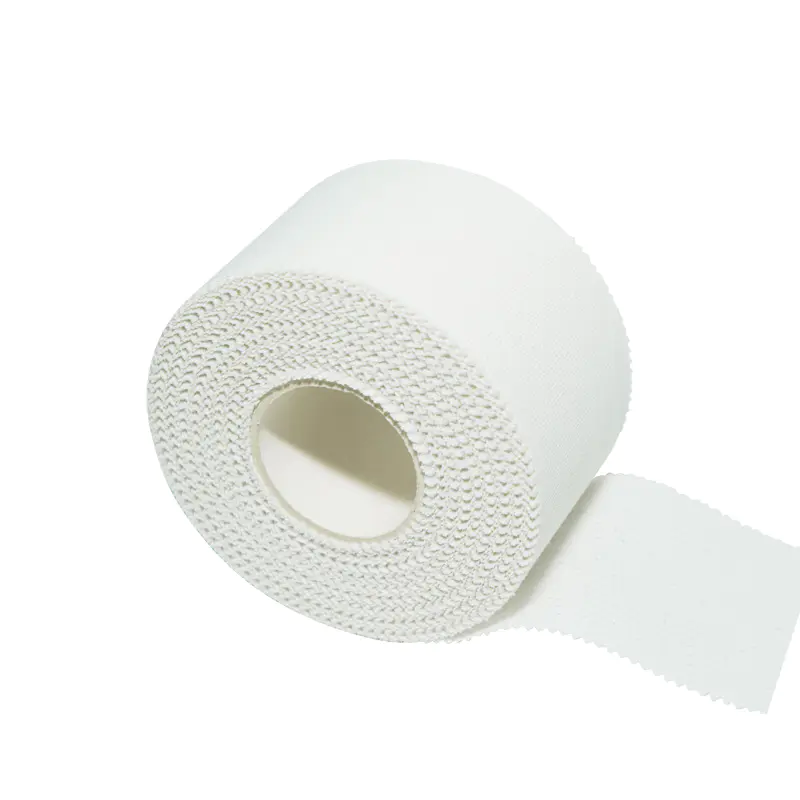Hockey tape, an indispensable tool for players of all levels, might seem like a simple accessory, but its composition is a carefully engineered blend designed to meet the rigorous demands of the sport. Far from being a single, monolithic material, hockey tape typically consists of a fabric backing coated with a specialized adhesive.
The foundational element of most hockey tape is its fabric backing, which provides the tensile strength and structural integrity needed to withstand the forces of slapping, shooting, and constant friction.
Cotton Cloth: Traditionally, and still very commonly, hockey tape utilizes a woven cotton cloth backing. Cotton is favored for its excellent conformability, allowing the tape to snugly wrap around sticks, pads, and even fingers without creasing excessively. Its natural fibers also offer a good balance of durability and a slightly tacky feel that can aid in grip. The weave of the cotton can vary, influencing the tape's tear strength and flexibility.
Synthetic Blends: In more modern iterations, some manufacturers incorporate synthetic fibers or blends, often involving materials like polyester. These blends can enhance certain properties such as water resistance, abrasion resistance, and overall strength-to-weight ratio. Synthetic backings might be chosen for specialized tapes designed for specific conditions or player preferences.
Equally critical to the tape's performance is its adhesive, which determines how well it sticks to the stick blade, the shaft, or other equipment, and how long it maintains its bond under stress.
Natural Rubber-Based Adhesives: Many traditional hockey tapes use a natural rubber-based adhesive. This type of adhesive is renowned for its strong initial tack and excellent elasticity, allowing it to form a secure bond and stretch slightly without breaking. However, natural rubber adhesives can sometimes leave a residue and may be more susceptible to degradation from moisture and temperature fluctuations over time.
Synthetic Adhesives (Hot Melt or Acrylic): Increasingly, manufacturers are turning to synthetic adhesive formulations, such as hot melt or acrylic-based adhesives.
Hot Melt Adhesives are thermoplastic polymers that are applied in a molten state and solidify upon cooling, offering a quick and strong bond. They are often very durable.
Acrylic Adhesives are known for their excellent aging resistance, UV stability, and resistance to moisture and chemicals. They tend to be less messy and offer a cleaner removal compared to some rubber-based counterparts. These synthetic options can provide more consistent performance across various temperatures and humidity levels, and are less likely to leave sticky residue.

While the core materials remain fabric and adhesive, specialized hockey tapes may incorporate additional features or materials:
Friction Tape: Often characterized by its very rough, cloth-like texture, friction tape typically uses a heavily impregnated fabric (often cotton) with a rubber-based adhesive that creates a highly abrasive surface. This is specifically designed for maximum puck grip on the blade.
Clear Shin Pad Tape: Unlike stick tape, this tape is designed for securing shin pads and socks. It's typically made from a polyethylene film (a type of plastic) with an adhesive backing. Its primary characteristics are its elasticity and transparent nature, allowing it to stretch and conform without being visually intrusive.
Grip Tape (for the Butt End): Some players use specialized grip tapes for the top of their stick (the butt end). These can be made from a variety of materials including foam, rubberized compounds, or textured fabrics, designed to offer enhanced tactile grip for the top hand.
The choice of materials for hockey tape is not arbitrary; it's driven by the specific demands of the game:
Durability and Abrasion Resistance: Tape must withstand constant contact with the puck, ice, and other sticks.
Adhesion and Cohesion: It needs to stick securely to the stick and to itself, and maintain that bond through impacts and moisture.
Conformability and Flexibility: The tape must be able to wrap smoothly around irregular shapes without wrinkling or peeling.
Moisture Resistance: Hockey is played on ice, so the tape must perform even when wet.
Feel and Control: For stick tape, the material influences how the puck feels on the blade and the player's overall control.
In conclusion, hockey tape is a testament to material science applied to sports. From the humble cotton cloth to advanced synthetic adhesives, each component plays a vital role in providing players with the grip, durability, and control necessary to excel on the ice.







